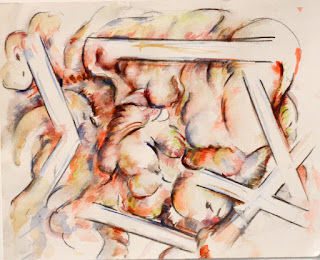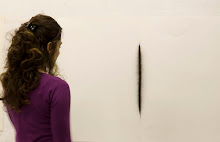Ach Alma Manetro is a decollage, or torn-poser work by Raymond Hains and Jacques de la Villegle made (or rather presented) in 1949.
The practice of the decollage artists was to raid the streets of Paris (or Rome) and collect pieces of torn billboard posters, which they presented as they found them, sometimes together with the support on which they were glued, or by subsequently mounting them on canvas with minimum adjustment. Sometimes they presented the works in the streets rather than in a gallery.
I am generally fascinated by the images created by torn posters around the city. I photograph them and I also collect posters in order to make artworks from them myself (with a lot of adjustments).
In discovering the decollage artists of the late 40s and 50s, I was therefore once more confronted with an image which I particulary like. However, the problem was that it seemed to me that as soon as one had seen a torn-poster (affiche laceree), one had seen it all. There is no big difference between a torn poster of today and a torn poster of then. Moreover, I could not easily accept them as art. A curious fact, I know. How can you be fascinated by something and still not accept it as art. Well I think it has to do with my belief that an artwork is not the presentation of a reality, but a transformation of reality. These seemed to be mere documents of reality. Not creations.
Reading about this work has made me reflect more deeply on whether it can potentially not be merely an interesting, even striking picture, but also a great work of art. Which in turn made me think some more about what the heck is a great work of art. Here we go.
Ach Alma Manetro is a great work of art because it is the complete and perfect solution to the artistic problems and questions of the day.
Which were the circumstances and artistic problems of the city of Paris in late 1940?
1. World War II. The artists had a living memory of and wanted to speak about an environment
devastated by war.
2. The restoration and rebuilding of cities was under way, and this restoration brought with it a new form of urban life, organized around consumerism and advertising culture. The way out of the strife of the war was proposed as the ability to consume better and ever- newer products.
3. Advertising takes on a huge part of public space. Large advertising posters are hung on billboards, forming atttitudes, guiding the world. The critique of advertising from the part of artists, the critics of the images of reality, is a must.
4. The artists had already seen the american Abstract Expressionist works, were familiar with the idea of Action Painting and the view of the canvas as an arena on which to act.
5. However, the particular circumstances of Europe, with its profound historicity, precluded mere gestural abstraction, with no deeper underlying meaning.
6. The artists were born in the city of the Surrealists and shared their ideas about uniting art and life, as well as imagination and reality and the idea of making the street the locus of the Magnificent.
7. The artists shared the Dadaists' and (especially) Surrealists' questioning of the idea of the artist as a genius. They wanted to develop more collective forms of creation.
8. The question was how to overcome the alienation which is the result of life in the modern city.
The discovery of decollage epitomizes all these requirements of the artists of the time. The torn poster is first and foremost an image that speaks about a rupture, a dislocation, even dismemeberment. It resembles a war zone. It is also an object created over time by the actions of anonymous passers-by as well as by the effects of the weather. Not by an individual artist. It gives us the image of an action, but we do not know whose action. No glory to the creator here. Moreover, Ach Alma Manetro in particular is not even the discovery of one creator. Two persons have discovered this together and presented it as a pair. The object was furthermore situated in the street. The continuous layering and tearing of the posters speak about a process of decay as well as creation, which ultimately creates an image of the passage of time in the realm of the urban environment. A kind of history of the city. It shows the relationship between degraded public space and radiant advertising space. The torn poster deconstructs language and communication, and at the same time proposes a new form of communication. It is therefore a critique of advertising. Advertising language is still there for the audience to see and ponder on its effects. It is in this sense the continuation of the project of the futurists and dadaists. The torn posters speak about the possibility of disalienation via the acceptance, understanding, manipulation and communication of the very products of this alienation.
Therefore, a found object (objet trouve) is the artwork par excellence of the time. No creator needed, no adjustment required, no artistic standards set or fulfilled. An art object is discovered, collected and presented as such. A ready-made.
Still have to persuade myself on this possibility, while my creation-greedy self moans.
On the other hand, what this work does not create is a transformation of reality. Of course, this was not the point for the artists. They wanted us to see reality in a different way. Anyway a transformation has already taken place, as the posters got changed by the actions of the passers by and the weather. However, at least for me, this remains an unanswered question, a thorn in the argument on whether Ach Alma Manetro is a great work of art.
p.s. Weeks after writing this post, I have come across a very interesting interview of Herbert Marcuse, in 1978. Marcuse says about the avant garde.
''Art in its radical forms—the present day avant-garde, for example: I would say yes, it is art. But the question is to what extent aesthetic criteria can be applied to some manifestations of avant-garde art. I had a long discussion on that here with the Visual Arts department two or three years ago. There was an exhibit that simply reproduced a garage sale. That wouldn't do because it just isn't art; it's a repetition of the given reality. It does not have the transcendence and dissociation which in my view are essential for art.''
Very clearly put...


































